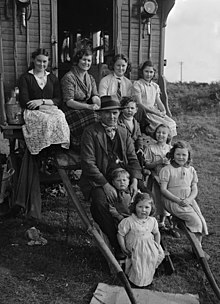Kale (Welsh Roma)
Kalá, Valshanange | |
|---|---|
 A Welsh Kale family, 1951 | |
| Total population | |
| 700 to 1,000[1] (1991, est.) | |
| Regions with significant populations | |
| Northwestern Wales | |
| Languages | |
| Welsh, English; historically Welsh Romani | |
| Religion | |
| Christianity | |
| Related ethnic groups | |
| Romanichal |
The Kale (also Kalá, Valshanange; Template:Lang-cy) are a group of Romani people in Wales. Many claim to be descendants of Abram Wood, who was the first Rom to reside permanently and exclusively in Wales in the early 18th century, although Romanichal Travellers have appeared in Wales since the 16th century.[2] Welsh Kale are almost exclusively found in Northwest Wales, specifically the Welsh-speaking areas. Romanichal Travellers inhabit South Wales (in and around Cardiff, Swansea and Newport) and North East Wales (in and around Wrexham as well as in parts of Wales close to Liverpool and Chester).
Generally speaking, the Kale have employed a tribal structure in which a group of several family units would be under the authority of a male chieftain. However some Kale families are matriarchal with a senior woman being chosen by consensus among the other women of the family to take the leadership role.
The Welsh Kale are extremely closely related to English Romanichal Travellers, Scottish Lowland Romany Travellers, Norwegian and Swedish Romanisæl Travellers and Finnish Kale.[3]
Language
Historically the Kale spoke Welsh Romani, though they were also (and remain) an important part of the Welsh speaking societies of the areas they have traditionally inhabited.
Originally the variants of Welsh Romani and the Angloromani of the Romanichal constituted a common "British Romani" language.[4] Both Welsh Romani and Angloromani share characteristics and are closely related to each other and to Romani dialects spoken in Scotland (Scottish Cant), Finland (Finnish Kalo) and Norway and Sweden (Scandoromani). Welsh, English, Scottish, Swedish, Norwegian and Finnish Romani share common ancestry from a wave of Romani immigrants who came to England in the 16th century.[5]
Integration into Welsh culture
While preserving their travelling lifestyle, the Kale grew to claim several aspects of Welsh culture, including the Welsh language, conversion to Christianity, taking on Welsh surnames, and participating in regional and national eisteddfodau. Notably, John Robert Lewis, the husband of Abram Wood's granddaughter, would win prizes for harping in 1842, 1848, and 1850.[6]
Another descendant, John Roberts,[7] earned the sobriquet "Telynor Cymru", and taught his whole family various instruments. His illustrious career culminated in a performance before Queen Victoria at Palé Hall in Llandderfel near Bala on 24 August 1889, on the occasion of the Royal Visit to Wales. John Roberts played with his nine sons, all of them on the harp.[8]
See also
- Romanichal Travellers (English Travellers)
- Romanisæl Travellers (Norwegian and Swedish Travellers)
- Finnish Kale
- Scottish Travellers
- Irish Travellers
Notes
- ^ Jarman, Eldra; Jarman, A. O. H. (1991). The Welsh Gypsies : Children of Abram Wood (1st ed.). Cardiff: University of Wales Press. ISBN 9780708311066. cited in Clark, Colin Robert (2001). Invisible Lives': the Gypsies and Travellers of Britain (PDF) (PhD). University of Edinburgh. p. 109.
- ^ "Welsh Gypsy, Welsh Gypsies, Kale, Wales". Archived from the original on 2008-06-21. Retrieved 2008-06-10.
- ^ "International Traveller and Roma Day 2019". Parish of the Travelling People. Retrieved 13 July 2020.
- ^ Sampson. J. (1926) The Dialect of the Gypsies of Wales. Oxford: Clarendon Press.
- ^ Bakker (1997) Review of McGowan, The Winchester Confessions, Journal of the Gypsy Lore Society, Fifth series 7(1): 49-50.
- ^ "Welsh Gypsy, Welsh Gypsies, Kale, John Roberts, Telynor Cymru". www.valleystream.co.uk. Retrieved 8 July 2021.
- ^ Griffith, Robert David (1959). "ROBERTS, JOHN (Alaw Elwy, also called ' Telynor Cymru '; 1816 - 1894), harpist". Dictionary of Welsh Biography. National Library of Wales. Retrieved 9 November 2017.
- ^ Roberts, E. Ernest (1978). John Roberts, Telynor Cymru (in Welsh). Dinbych: Gwasg Gee. OCLC 4957891.
References
- The Welsh Gypsies: Children of Abram Wood, Eldra Jarman, A. O. H. Jarman, University of Wales Press, 2011, ISBN 978-0708323984
